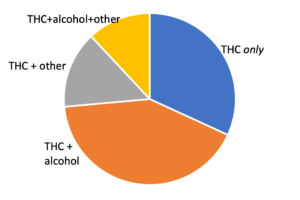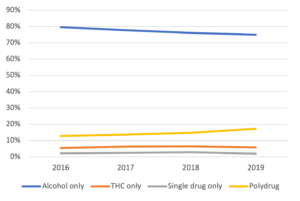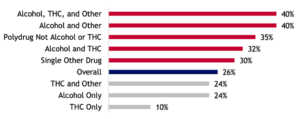 Colorado’s 2021 report “Driving Under the Influence of Drugs and Alcohol” was released, covering arrests occurring in 2019. The report was delayed, hoping to capture more judicial activity on those arrests, activity that was delayed by COVID 19. It was worth the wait. This is the best report yet. Here are some highlights:
Colorado’s 2021 report “Driving Under the Influence of Drugs and Alcohol” was released, covering arrests occurring in 2019. The report was delayed, hoping to capture more judicial activity on those arrests, activity that was delayed by COVID 19. It was worth the wait. This is the best report yet. Here are some highlights:
2021 report “Driving Under the Influence of Drugs and Alcohol”
DUI is not just about alcohol, and DUID is not just about marijuana
Over 100 different impairing drugs were found in drivers in 2019. The most common drugs found were alcohol followed by marijuana’s THC, methamphetamine, and alprazolam (Xanax). [Appendix A p73ff]
Most THC-positive drivers were impaired by multiple drugs (polydrug impairment)

68% of THC-positive drivers arrested for DUI also tested positive for other drugs. [Table 21, p44]
Colorado convicts about 900 drivers impaired by THC each year
Colorado convicts ~900 drivers per year of impaired driving when THC was the only impairing substance found in their blood. This is convincing evidence that THC impairs drivers. These drivers were convicted and sentenced for their crimes. [Table 35, p57]
The conviction rate of stoned drivers is lower than that of drunk drivers (74% vs 92%)
The conviction rate of drivers impaired by THC only is lower than the conviction rate of drivers impaired by alcohol only. The conviction rate of drivers impaired by THC only has improved from 69% in 2016 to 78% in 2019. [Table 35, p57]
Polydrug use is more common, more dangerous, and faster growing than other drugs
Polydrug impairment is more common than impairment from drugs other than alcohol and it is growing more rapidly than any other cause of impairment. [Table 21, p44]

Polydrug impairment is far more dangerous than impairment from either alcohol only or THC only [Table 35, p57]. Only 2.9% of Colorado’s non-impaired drivers are involved in a crash each year. Crash involvement for convicted impaired drivers was much higher, regardless of cause:

A toxicology test in not needed to convict a driver of DUI
A drug toxicology test is not needed to convict a driver of DUI. 37% of the reported cases had no toxicology test yet had an 84% conviction rate vs a 90% conviction rate for those with a toxicology test. [Table 28, p51]
Stoned drivers don’t necessarily drive more slowly than sober drivers
25% of stoned drivers were also charged with speeding. That’s a higher speeding rate than any other impairing drug or combination of drugs. Drunk drivers were second at 14%. So much for the myth that stoned drivers are careful drivers because they go more slowly. [Appendix G, p96]
Drugged drivers are undercounted
Approximately one-third of all Colorado drivers arrested for DUI refuse to submit to a toxicology test, despite the state’s expressed consent law. We have no drug data on those drivers. If an arresting officer believes that a driver’s observed impairment is caused by alcohol, the driver may choose to be tested by an evidentiary breath testing device. We have no other drug data on those drivers. Until July 2019, drug testing was only done when an arresting officer believed it was essential and the law enforcement agency had the budget for it. Beginning July 2019, all blood samples drawn for DUI forensic testing included a state-funded full drug panel. As a result, THC-positive cases jumped from 36% of all tested drivers in the first half of 2019 to 42% in the second half. Polydrug cases jumped from 30% to 44%. [Table 15, p37]
Colorado’s 5 ng/mL THC permissible inference law is ineffective
In 2013 Colorado passed its 5 ng/mL THC law. There is a permissible inference that the driver was impaired by THC when the toxicology test was at least 5 nanograms of THC per milliliter of whole blood. The law was passed for the same reason that alcohol .08 gm/dL per se laws were passed – to make it easier to convict drivers of DUI.
Alcohol’s maximum .08 gm/dL per se laws are supported with scientific evidence of a very high correlation between blood alcohol levels and risk of traffic crashes.
Unlike with alcohol, there is no correlation between blood THC levels and risk of traffic crashes or levels of impairment. The same is true with all other drugs except alcohol. Alcohol is the exception.
The results are now in. The 5 ng law is a failure. Conviction rates of drivers arrested for THC impairment remain lower than other causes. The law makes conviction harder for drivers impaired by THC when the forensic toxicology results are below 5 ng/mL.
Colorado unwittingly launched a natural experiment to test the utility of a THC 5 ng law since the state uniquely has two impaired driving infractions:
DWAI – impaired to the slightest degree, and
DUI – incapable of safe driving
The 5 ng/mL law applies only to DUI, not to DWAI
The 2021 Driving Under the Influence of Drugs and Alcohol analysis revealed that:
- Overall THC DUI convictions are dramatically lower than overall alcohol DUI convictions, or convictions of drivers impaired by other drugs,
- The 5 ng/mL law prevented most DUI convictions of drivers who tested below that level, even though drivers withany level of THC were nearly always impaired,
- Most impaired driving convictions were for DWAI without the aid of the 5 ng law, not for DUI, and
- The overwhelming majority (93%) of drivers testing below the 5 ng/mL THC level were convicted of DWAI, not DUI THC only
Charge Charges Convictions Conviction% DUI 5ng+ 221 155 70% DUI <5ng 98 8 8% DWAI 5ng+ 372 370 99% DWAI <5ng 56 52 93% Contrary to the language of the law, a driver convicted of DWAI is not necessarily less impaired than a driver convicted of DUI. That is because DWAI is commonly used as a plea bargain tool. This can be confirmed by studying the comparable data for drivers arrested for DUI where alcohol was the only drug found forensically. 45% of drivers with a BAC greater than the alcohol per se level were still convicted of DWAI, not of DUI.
Alcohol only Charge Charges Convictions Conviction % DUI .08+ 5,397 5,032 93% DUI .05-.079 91 24 26% DWAI .08+ 4,096 4,094 100%
For THC-impaired drivers, most convictions were for DWAI. For alcohol and polydrug-impaired drivers, most convictions were for DUI.
| Polydrug with THC | |||
| Charge | Charges | Convictions | Conviction% |
| DUI 5 ng+ | 496 | 370 | 75% |
| DUI <5ng | 394 | 327 | 83% |
| DWAI 5ng+ | 267 | 267 | 100% |
| DWAI <5ng | 218 | 217 | 100% |
